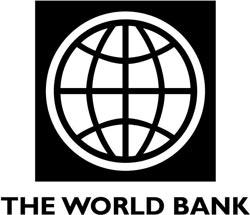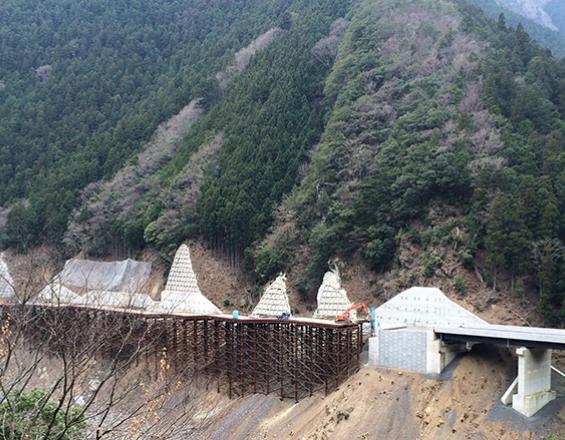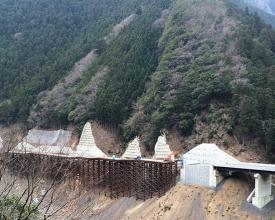
Resilient Infrastructure: Roads, landslides and Disaster Risk Management

Geohazards are on the rise globally due to increasing potentially hazardous infrastructure built-in areas, the effects of climate change, and pose an increasing threat to road infrastructure that is critical to trade, industry, public health, quality of life, safety, and economic productivity. Japan is especially at risk of geohazards such as earthquakes, floods, landslides and tsunamis due to its unique set of geographical, meteorological and topographical conditions. Led by the Ministry of Land, Infrastructure, and Transport (MLIT), Japan has developed its capacity to manage road geohazard risks through extensive experience of disasters, such as the 2011 Great East Japan Earthquake. The Government of Japan has built resilient road infrastructure through effective institutional coordination, addressing key challenges in an integrated manner, and applying structural and non-structural measures to its road systems.
Context
Challenges addressed
- Roads in Japan must be protected from numerous geohazards including rockfall, rock and soil collapse, landslides, flows, and erosion due to the country’s topographical and geographical context.
- Japan’s location in the Pacific earthquake belt exposes it to frequent earthquakes and tsunamis, which can disrupt road networks and result in significant losses. For example, the 2011 Great East Japan Earthquake forced the closure of 15 expressways, 69 national highways, and 638 prefectural and municipal roads, which hampered rescue efforts and inhibited delivery of relief supplies.
Location
Process
Summary of the process
The five building blocks are all key aspects of effective road geohazard risk management and can be mainstreamed within government strategies and development plans. These principles can be applied to each of the stages of road development; institutional arrangements, planning, design, construction, operations, maintenance, and post-disaster. While the costs of structural measures can be high, cost-effective nonstructural measures, such as emergency information dissemination and multi-stakeholder planning and coordination (e.g., local/national government and private sector), can contribute significantly to effective risk management of geohazards. Successful implementation of these building blocks can help to reduce impacts of geohazards on human life, assets, and the natural and built environment.
Building Blocks
Establishing an adequate institutional framework
Relevant institutions in Japan work together to create and enact appropriate laws and regulations, as well as national and local government plans and strategies (e.g., Japan Rail, local government, and Ministry of Land, Infrastructure, Transport and Tourism collaborating on road geohazard risk management). Japan’s framework also includes institutional and technical coordination, and appropriate funding mechanisms. For example, the cost of adding height to an expressway can be shared by both public works organizations and disaster risk management organizations. These types of cost-sharing mechanisms ensure that financial burdens are shared equitably.
Enabling factors
- Political will to establish adequate institutional framework, laws, and regulations.
- Financial resources to implement funding mechanisms.
Lesson learned
- Disaster risk management organizations and public works organizations can share costs of certain infrastructure investments.
- National and local government and other key stakeholders should coordinate strategies related to disaster risk management, including the use of infrastructure and public facilities such as roads, highways, and railways. These facilities can be used to enhance disaster management procedures and operations in the event of geohazards such as floods, tsunamis, and landslides.
Conducting risk assessment of geohazards and planning for both new and existing roads
Roads, expressways, and other public facilities helped reduce damage and loss of life in the 2011 Great East Japan Earthquake by providing protection against flooding, owing largely to successful risk assessments carried out pre-construction. For example, the East Sendai Expressway (elevation of 7 to 10 meters) acted as a secondary barrier against the incoming tsunami, preventing the waves from penetrating further inland. Over 200 people escaped by running up to the expressway, and its embankment served as an evacuation shelter for local residents.
Enabling factors
- Having sufficient resources to conduct risk assessments.
- Availability of relevant data to conduct accurate assessments and inform planning of new and existing roads.
Lesson learned
- Pre-concept risk identification is crucial. For new roads, geohazard risk evaluations enable management authorities to make informed decisions on how to avoid hazardous locations.
- Hazard mapping, evaluation of exposure levels, and determining potential impacts on the social environment are essential for holistic road geohazard risk management.
- Determining potential economic impacts incurred from loss of road access and conducting a cost-benefit analysis of potential investments to mitigate geohazards are critical. The results of these assessments help identify and prioritize endangered locations and inform risk reduction measures.
Implementing structural measures to reduce the risk of road damage
After the 2011 Great East Japan Earthquake, the main highways and roads to the affected areas were back up and running within weeks, which greatly expedited relief and recovery operations. This was largely due to robust structural measures, in conjunction with efficient recovery work by public services. In contrast, it took over 1 and a half years for the highway to be reconstructed after the Great Hanshin-Awaji Earthquake in 1995.
Enabling factors
- Financial resources and will to invest in structural resources.
- Technological and engineering capacity to implement large-scale structural measures.
Lesson learned
- Structural measures reduce the risk of road damage due to geohazards, reduce road maintenance costs, ensure connectivity during and after disasters, and contribute to the speedy recovery of a road after geohazard events.
- Bio-engineering and other types of structural measures can be implemented during the road construction, operation and maintenance stages.
- A thorough assessment of geographical, geological, geotechnical, hydrological, and hydraulic conditions are essential for the effective design of structural measures.
Making additional non-structural risk reduction measures
Non-structural measures for road geohazards are those that do not involve physical construction and are often less expensive that structural measures. For example, Japanese highways often have roadside stations (michi-no-eki), which have been strategically planned to serve as evacuation centers and hubs for disaster-related information (e.g. road conditions and emergency information). After the 2011 Great East Japan Earthquake, roadside stations and highway parking areas were used by numerous teams and organizations as operational bases for rescue and relief efforts. Many of them were equipped with electricity, food, and water supplies, and served as emergency shelters, where important information was shared with members of the public.
Enabling factors
- Financial resources to develop and implement non-structural risk reduction measures.
- Technical know-how and capacity to develop and implement non-structural risk reduction measures.
Lesson learned
- Non-structural risk reduction methods, such as early detection and emergency information collection capabilities, development and implementation of emergency preparedness and response plans, and engaging stakeholders to reduce geohazard risks and raise public awareness, are critical to disaster risk management of roads.
- Non-structural risk reduction measures can be a cost-effective way to reduce human and economic losses resulting from geohazard events.
Conducting post-disaster activities
Authorities activated pre-arranged agreements to mobilize contractors immediately after the 2011 Great East Japan Earthquake, as part of what became known as “Operation Toothcomb”. The Ministry of Land, Infrastructure, Transport and Tourism (MLIT) implemented a strategy to ensure that the Tohoku expressway (an arterial road running from Tokyo to the northern tip of Japan’s Honshu island) was made passable as soon as possible, to enable delivery of relief supplies and expedite the response. As a result of this fast and coordinated response, 97 percent of the national coastal highways were accessible by 18th March, just 1 week after the earthquake struck. Additionally, the entire Tohoku Expressway was open to general traffic within 13 days of the earthquake’s occurrence.
Enabling factors
- Coordination across government sectors, as well as with stakeholders in private and public spheres.
- Robust systems to ensure timely and accurate implementation of emergency inspections and post-disaster assessments.
Lesson learned
- Emergency inspections and assessments should be conducted together with nonstructural measures in the wake of a disaster.
- Comprehensive planning, including procedures needed for resilient recovery, rehabilitation, and reconstruction, is critical.
- If cars or drivers are exposed to any substantial risk, emergency traffic regulations and public notification systems must be activated immediately.
Impacts
Economic
- Sound planning and alignment of new roads can result in significant savings in construction costs and subsequent maintenance costs, such as repairing locations damaged by geohazard events.
- Effective road geohazard risk management ensures that economic losses are limited by minimizing road disruptions. Roads rendered inoperable by hazard events can incur many forms of economic loss, including increased transaction costs, loss of productivity, and destruction of resources.
Environmental
- Building, managing and maintaining road structures to withstand shocks and stresses can limit adverse environmental impacts, such as the environmental costs of acquiring and allocating resources for re-building roads.
- Ensuring that roads are safe and passable can also potentially save on energy resources that would be required if the road were to be disrupted.
Social
- Reliable roads are a key enabler for rapid and effective response in post-disaster contexts. Search and rescue operations, transporting of casualties to hospitals, access to emergency shelters, and provision of relief supplies are heavily dependent on roads being operable during and after emergencies.
- Roads, expressways, and other public facilities helped reduce damage and losses by providing protection against flooding, and by serving as evacuation routes and base stations for emergency operations.
Beneficiaries
- Government authorities.
- Local communities.
- Private sector entities.

